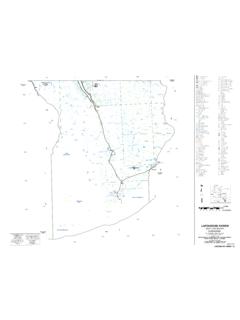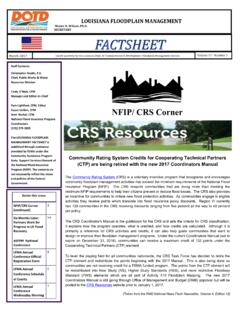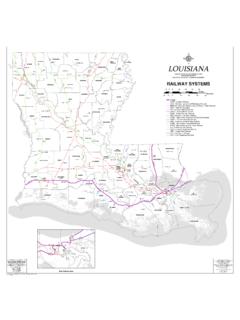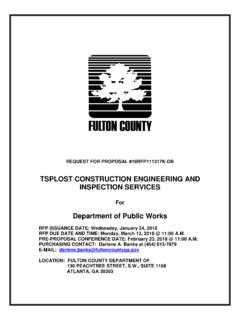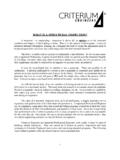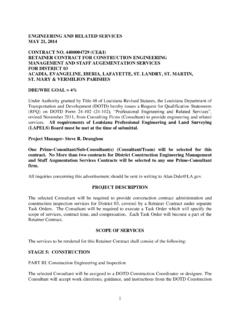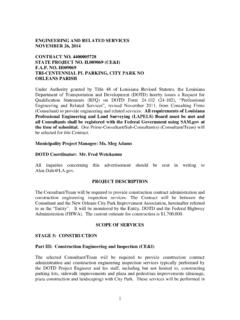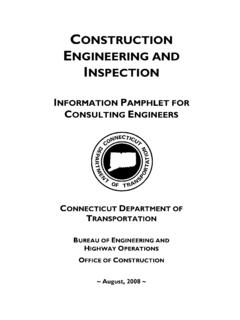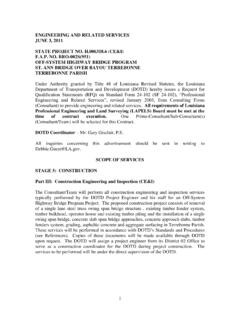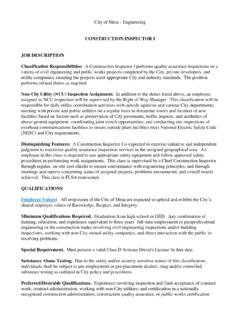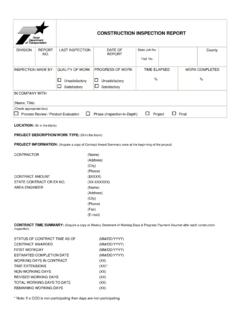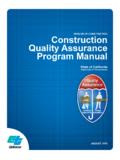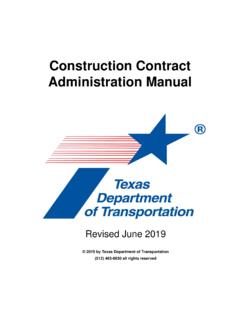Transcription of Construction Engineering & Inspection - Louisiana
1 Construction Local Public Agency (LPA) Appendix 2011 Construction Engineering & Inspection Local Public Agency (LPA) Appendix 2011 Construction Inspection Program United States Code 23 USC114 state the Construction of any highways or portion of highways located on the Federal-aid system shall be undertaken by the respective State transportation departments or under their direct such Construction shall be subject to the Inspection and approval of the Secretary. Stewardship Agreement Each FHWA Division Office has a unique Stewardship Agreement with its State DOTD. The Louisiana Stewardship Agreement was signed in 2007. Based on a core set of rules and regulations that apply to all states, it focuses mainly on Interstate and National Highway System (NHS) projects, but established an oversight and delegation table under Title 23 Section 106.
2 TYPE OF PROJECT OVERSIGHT RESPONSIBILITY Interstate projects with an estimated Construction cost >$1 million. FHWA Interstate projects with an estimated Construction cost <$1 million. DOTD NHS (non-Interstate) projects with an estimated Construction cost >$10 million. FHWA NHS (non-interstate) projects with an estimated Construction cost < $10 million. DOTD Non-NHS and locally administered projects. DOTD Major Projects (>$500 million). All routes. FHWA Bridge Projects on any route with an estimated Construction cost >$50 million. FHWA All ITS projects (see note 2 below) FHWA Note 1: NHS-projects are defined by system, irrespective of Federal funding source.
3 Note 2: As defined by 23 CFR 940 an ITS project is any project that in whole or in part funds the acquisition of technologies or systems of technologies that provide or significantly contribute to the provision of one or more ITS User Services as defined in the National ITS Architecture. Exceptions: 1. State Administered projects (delegated) may be selected for full oversight by mutual agreement between FHWA & LADOTD. The selection will be agreed upon by the FHWA Assistant Division Administrator and the LADOTD Chief Engineer. Examples of projects which may be selected: Complex emergency relief projects, Major or complex bridge structure projects, or projects which involve a high degree of public controversy or environmental impacts.
4 2. A full oversight project may be delegated by mutual agreement between FHWA & LADOTD. The selection will be agreed upon by the FHWA Assistant Division Administrator and the LADOTD Chief Engineer. Examples of projects likely to be selected: NHS projects which do not affect traffic such as landscaping, rest area Construction , fencing, signing and enhancement projects. FHWA Construction Inspection Expectations from DOTD The purpose of an on-site Inspection is to evaluate the project activities, determine the quality and progress of the work and follow-up on any findings from previous inspections. The Inspection will combine a field review of the physical work and actual conditions with an office review of administrative actions and documents supporting the field work such as field books and diaries, material certifications and invoices and payrolls.
5 The data gathered from the inspections is useful for many things. Information is acquired on problems and Construction changes. It provides an opportunity for timely remedial action where applicable. It documents the solutions to problems or commitments. It encourages the DOTD units involvement and awareness of problems to avoid future reoccurrence. It evaluates the State s abilities and effectiveness in managing Federal-aid Construction projects with respect to items such as: qualifications-training, certification, written guidance, staffing, equipment, facilities, performance, project documentation, including Inspection diaries, test reports, etc. Inspections are also used to offer technical and procedural advice.
6 It allows for the transfer of knowledge on special or innovative Construction materials, methods, procedures, new equipment, and other technological innovations All inspections must be documented by an Inspection report, photos, project documents and project staff interviews (DOTD and contractors) in accordance with the Construction Contract Administration Manual (located on the DOTD internet site: Construction / Construction Contract Administration Manual) Typical Types of FHWA Inspection Initial Inspections This is the first Inspection of an active Construction project. Actual Construction work may be limited due to the early stage. Establishes the scope, communications and commitments Intermediate Inspections These are recurring project Construction inspections.
7 The frequency established by Stewardship Agreement. In Louisiana , a minimum of once every 3 months was established for interstate, NHS projects and other full federal oversight projects. The Inspection includes all aspects of the project In-Depth Inspections This is a detailed Inspection . It involves the review of the specifications, procedural manuals, and the specific contract requirements. Some of the subjects for these inspections may include: bridge decks, structural concrete, hot mix and Portland cement concrete pavement, aggregate bases, earthwork, erosion and sediment control. These may be made on an individual projects basis or may be part of a statewide federal process review effort.
8 Final Inspections A final Inspection is used to determine the extent and obtains assurance that the project has been completed in reasonably close conformance with the plans, specifications and authorized changes and extra work. A final Inspection may be accomplished by an on-site review conducted at or near the completion of work and a review of project records that are provided by the State at the completion of work. This Inspection provides a basis for the acceptance of the project and reimbursement of the project costs with Federal-aid funds. Specialty Inspections An Inspection may be performed on any experimental or innovative Construction feature or procedure.
9 Items FHWA Considers During Inspection Progress and quality of work Workmanship Changes and extra work including time extensions Claims and potential claims Project Records and Documentation o Quantity and quality of materials delivered, used and rejected o Construction work performed o Methods and frequencies of checks on scales and other measuring devices o Adequacy of field notes, diaries, and records supporting pay quantities o Subcontracting o Labor compliance, equal employment opportunity, and on-the-job-training Compliance with Americans with Disabilities Act (ADA) commitments and permit stipulations (erosion/pollution control, 106 Cultural SHPO, 404 permits COE, Section 7 FWS, etc.)
10 Compliance with contract requirements (number of lanes, width of roadway/shoulders, clearance on structures, etc.) Staffing, and Inspection qualifications Review of Work Items Right-of-way clearance, demolition Utility relocations Clearing and grubbing Earthwork and grading Environmental o Erosion and sediment control o Dust abatement o Construction noise o Other environmental commitments Drainage and minor structures Major structures Sub-base and base Paving o Flexible o Rigid Work Zones o Traffic management and traffic control planning o Installation and maintenance of traffic control devices o Worker and traveling public safety Appurtenances o Signs and Signals o Lighting o Fencing and Guardrail o Intelligent transportation system (ITS)




